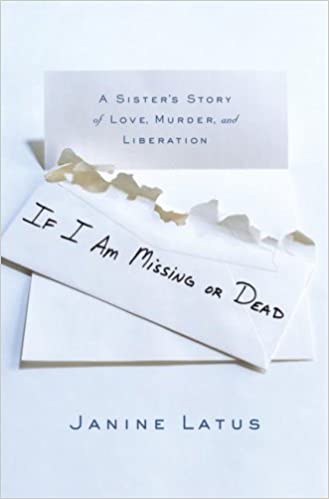
Reporting is one step. Writing is another. It seems like that should be enough. But if you want great sales, there are a lot of steps that follow. Here are a few that worked for me.
Step One: Be so in love with your book idea that you will eat sleep breathe and be identified by it for years. If you make bestseller you are your book. This may be particularly true for authors of memoirs, but other bestsellers I’ve known say they spend years with the book’s title as their name, much like for the past decade a subset of the population has called me only ‘Kylie’s mom.’ Now I am also the ‘Missing or Dead lady.’ [Janine is the author of If I Am Missing or Dead.]
Step Two: Tap your network. I ran my proposal past four ASJA friends/colleagues. One line edited it. One said it was fine as is. One said something else, and one said I was going about it all wrong and if I did not think his way was better than perhaps he should not be an advisor on the project. He was absolutely right. When people you respect critique your work, listen.
Step Three: Find an agent who is excited to represent your book. I approached four agents. Two are participants in ASJA, one had spoken at an ASJA conference, one had represented a book similar to mine that I admired. All four wanted to represent my book, in part because the topic — domestic violence — touched someone in their own lives and they therefore could imagine the size of the audience. I chose to work with the one who repped the book I admired. We shared a vision for my book and she was thrilled at the prospect of bringing it to the public. Tepid would be bad.
Step Four: Sell the book for a lot of money. We sold the British rights first, which is unusual, and then went to auction for the rest of the world rights. You want a big advance because the more money the house has invested, the more it will publicize and try to get its investment back. My editor sent my book to something like eighteen editors. Sixteen wanted to see the full proposal. Some of those sixteen were under the same publishing umbrella (big publishing houses have multiple imprints that are not allowed to compete for the same book) so when we went to auction all sixteen could not come to the table. One house offered me a bunch of money and a publicity plan they compared to Lovely Bones to take it off the table. Instead we used that house’s offer as the floor for the auction. Eight houses came in. The auction took forty eight hours, during which my dominant thought was, ‘my book is going to be published.’ Again I chose the editor whose vision of the book and whose passion aligned with mine. It was an arranged marriage without a blind date, and it worked beautiful, in large part because of her commitment to the book. She rocks.
Step Five: Create concentric circles of publicity energy. I tapped every connection I had. My ASJA colleagues were one circle. I had given talks for the state coalitions against domestic violence and had partnered with the National Network to End Domestic Violence. I made myself available as a speaker. I talked to people on the phone. I flew anywhere anyone wanted me to fly in order to speak to audiences, some of which were tiny, some were overwhelming. Once I spoke to a mandatory panhellenic council meeting at a university. That means every member of a sorority at that school was required to attend. It was profound.
This started well before my book was written and continues today. I still spend at least an hour a day answering reader e-mails, mostly because these people are baring their souls and deserve my attention, but also because I know they will tell others that I wrote back, which will spur word-of-mouth sales. I answer Facebook and MySpace posts. I write to people whose domestic violence tragedies make the paper. All of this takes away from my fresh writing, but it advances the cause and the book and is therefore part of my job.
Step Six: Take whatever help you can get. Simon & Schuster ran me through media training. That meant I sat in a room being interviewed while two publicists and my editor looked on. We then looked at and picked apart the video tapes. First thing I learned? The answer is not written on the ceiling. Second? That I lean. Sit up straight, look the interviewer in the eye, know your key points.
S&S also set up a radio book tour. Some days I would handle ten back-to-back interviews. Things I learned: stand up when you’re speaking, smile, have your talking points in front of you. I had half a dozen things I wanted to make sure I said, regardless of the question asked. I did not want to say, ‘have I already told you this?’ nor did I want to hang up after a blazing-fast interview and whack myself on the head for not having said something important, so I printed out ten copies of my key points and crossed them off as I went along. Deep breath, a couple of jumping jacks, next interview. Always think about that person in the car, listening.
I was supposed to do a lot of TV but a major host (whose name starts with an O) demanded first interview and then, after we’d turned down multiple major offers, cancelled. I made bestseller without her, which felt good.
S&S bought front-of-store placement at bookstores, which caught me impulse shoppers, but a ton of my sales came from non-bookstore venues. There were stacks of Missing or Dead at Costco and BJs and Target (it’s still in Target three years later), which meant I was reaching people who did not go into bookstores. S&S got me reviews in Publisher’s Weekly, Kirkus, and some of the women’s magazines. I was one of three books reviewed each month in Elle. I got three quarters of a page in People. No, I did not get reviewed in the NY Times Review of Books, but more people read People. (I was at the ASJA conference in New York, at a Duane Reade with a good ASJA friend at midnight when I first saw the People review and started hooting. Luckily it was midnight and the store was pretty empty.)
Step Seven: The rich get richer. I spent something like six weeks on the NY Times bestseller list. You’d think I’d remember. It was in the top ten for at least three of those. Missing or Dead made the Sunday Times of London bestseller list twice, once as a hardback – for a couple of weeks – and then again when it came out in paperback, making it to No. 2 that time. (Behind that darn John Grisham, who also lives in Virginia. I sent him an e-mail to chortle about two Virginians being One and Two in Britain. No response.) The Brits put big posters up in the Tube. I flew there and did British TV. I went bestseller in Canada, too, and have so far been translated into or contracted to be translated into six languages, including Turkish and Indonesian. The paperback has “New York Times bestseller” across the top, which makes even more people read it. Every kudo leads to more attention which leads to more sales.
Step Eight: You can do this. Maybe you don’t have a topic that resonates as deeply with editors. You still have to love it insanely. My experience has been like giving birth to a particularly gifted child and watching in amazement as she grows up to make the world a better place. Love your topic, love each sentence, believe you can fly. In writing this handout I looked back at a document I kept through the process – What it’s like to write this book – and saw that I believed from the minute I got the contract that we were going to create a bestseller. Had I been wrong, so what? The document was for me, not for public consumption. That belief, though, gave me the courage to keep reaching for something bigger, in myself and in the publishing experience. Tap your friends, tap your professional networks, tap ASJA, tap your cousins and your friends and anyone else you think could be of help. Maybe they’ll say no, maybe they’ll say you’re over-reaching. So? No one will love this book as much as you do, so even if you get the big publicity deal, it still falls to you to bring the passion.

